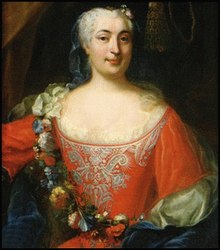Hedvig Taube

Hedvig Ulrika Taube (1714 – 11 February 1744) also Countess von Hessenstein was a Swedish noblewoman and salonist, official royal mistress to King Frederick I of Sweden. She is generally considered to have been the only official royal mistress in Swedish history, and she did have some political significance.
Background
Hedvig Taube was the daughter of a noble family,[1] who suffered from gambling debts when the king noticed the beautiful sixteen-year-old daughter of the family in 1730. Her sister, Catherine Charlotte, was to marry the brother of the famous scientist Countess Eva Ekeblad, aunt of famous Axel von Fersen the Younger. King Frederick I, nearing sixty, was at this point more and more infamous for his sexual excesses. The young girl at first refused him, but she was exposed to a great effort of persuasion; first, court officials came and offer her the formal position as a lady-in-waiting to the queen, while it was understood that she would in reality be the mistress of the king. Both the king's friends, among them her relatives, and her own family united themselves in the persuasion; she had nine siblings, and her family suffered from gambling debts at the time of the king's suggestion. Carl Tersmeden held a speech to her calling her future fate as more beautiful than she could imagine, the wives of two noblemen of the court visited her to make her give in, her mother, her paternal and maternal aunts all did what they could, and eventually, her resistance was broken. When the carriage came to take her to court, Tersmeden reported her saying; My fate is harder than I could imagine. I am being forced to expose my virtue to save a family ruined by gambling.[2]
She was installed at court as lady-in-waiting to queen Ulrika Eleonora in 1731, and apparently became more to the king then merely a sexual plaything. On 1 March 1733, Hedvig gave birth a daughter, called Frederica Wilhelmina.
Public scandal
In 1734, shortly after her one-year-old daughter died, the king had the Holy Roman Emperor grant her the title of Countess von Hessenstein, acknowledged her as his official mistress and gave her her own palace to live in with her own household. This caused a great scandal, as she thus was the first official royal mistress in Swedish history. Of course, many Swedish kings had mistresses, but they had never previously been official, in the "French way". The Queen locked herself in her rooms, the priests refused to pay homage in the churches to a king "with two wives", satirical pamphlets circulated in Stockholm, the opinion of the public greatly favoured the Queen, as she was respected for her pious behaviour and the last of the old Swedish dynasty, and leaders of the government reminded the king of his promise to always "treat the queen with respect" when she abdicated in his favour. The king publicly acknowledged his offspring with Hedvig, and denied the rumors that he was to have married Hedvig in secret, but answered that the matter of treating the Queen with respect out of gratitude for her abdication had nothing to do with his private life, and wrote a letter to the Queen and asked her to protect Hedvig after his death.
The Queen had the bishops of the parliament's clerical group lecture both Hedvig and the king; the king answered that the government had promised not to get involved in his personal affairs and refused to accept a written protest. Hedvig followed the manner of the queen and pretended to be sick, but the bishops forced their way in to "The public sinner" and lectured her lying in bed with half of her face covered by a sheet. She said to them, "I had no idea that Her Majesty was displeased because of this," and the bishops replied "We can assure you miss that it is so, and how else should it be?", and she said to them that they should have lectured her when she was younger and defenceless. They said that they were discussions to expel her from the country, and she answered that they should have more important things to discuss than someone who was never involved in politics.
Royal mistress and salonist
The countess herself lived an unhappy and discreet life. After her first public appearance at court after her acknowledgement in 1735 the Queen protested by claiming to be indisposed and refused to leave her rooms, and after this, Hedvig never appeared at court again. She had never wanted to be a mistress, and when foreign ambassadors visited her to ask her to use her influence, she told them she had none and that she did not wish to have any. She did, however, became a noted patron of artists, and her salon became its own little court that rivaled that of the religious Queen; one of her favorites was the poet Olof von Dahlin, who was regarded as somewhat of the Court Poet. Indirectly, however, she really was to play a political role. She had a lot of influence when it came to the offices appointed by the king; it was said, that one need only to be recommended by her to become a favorite to the king and receive an office. Her court was the center of the Gylleborg party, which opposed Arvid Horn, who had opposed her position as mistress, but she herself favoured Horn, as she had been opposed to her position herself, and refused to be influenced to be anything but neutral during the 1739 election.
On 10 March of that year, Hedvig bore a second child, a son, named Fredrik Vilhelm, later Prince of Hessenstein. Two years later, on 26 November 1737, she gave birth to his third child and second son, Karl Edvard, created Count of Hessenstein, who died unmarried in Paris in 1769.
Almost exiled
The indignation about the fact that the king had an official mistress did not cease, and was discussed in parliament several times from 1738 forwards and greatly contributed to the impopularity of the king. In 1739, the Queen wanted Hedvig and her two sons expelled from the country; and they left for Hesse, but Hedvig stayed behind in Nyköping, where the king met her, claiming to go hunting, and she never left the country. This enraged the Queen who refused to leave her room for fourteen days, which was said to have contributed to the Queen's declining health, and Hedvig continued as his mistress. King Frederick, however, continued his use of prostitutes in parallel, which worsened his reputation more and more over the years, as this behaviour increased.
Later life

Hedvig was introduced to the new Crown Prince Adolf Fredrik in 1743; on 9 December of that year, she gave birth to Frederick's fourth child and second daughter, Hedvig Amalia, created Countess of Hessenstein, who died in 1752 only nine years old.
The next year (1744), Hedvig became pregnant again. She died in childbirth and was buried in the church of Strängnäs together with her stillborn daughter. After her death, Frederick made himself a public laughing stock by hiring prostitutes off the streets. In 1745, Taube was replaced as an official royal mistress by the noblewoman Catharina Ebba Horn, who was also officially recognized and given the title of German-Roman countess, but their relationship ended after three years and she has been largely forgotten by history.
References
- ^ Template:Genealogics name
- ^ Herman Lindqvist (2006). Historien om alla Sveriges drottningar (The history of all the queens of Sweden) (in Swedish). Norstedts Förlag. ISBN 9113015249.
- Admiral Tersmedens memoarer (The memoires of Admiral Tersemeden) (Swedish)
- Herman Lindqvist (2006). Historien om alla Sveriges drottningar (The history of all the queens of Sweden) (in Swedish). Norstedts Förlag. ISBN 9113015249.
- Herman Lindqvist (1996). Historien om Sverige- Nyttan och nöjet (History of Sweden - Usefullness and joy) (in Swedish). Fälths. ISBN 91-1-951282-1.
- [1] Wilhelmina Stålberg: Anteqningar om svenska qvinnor (Notes on Swedish women) (Swedish)
- Åke Ohlmarks: Svenska krönikan (Swedish Chronicle) (Swedish)
- http://www.historiesajten.se/visainfo.asp?id=187
